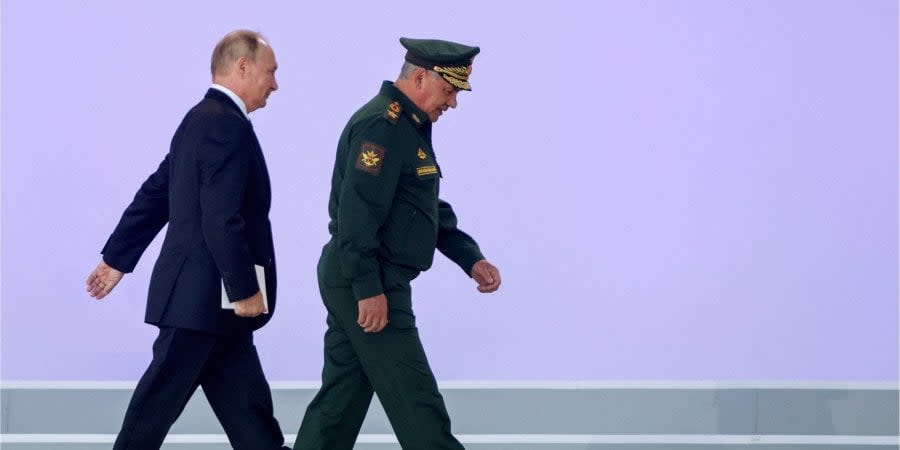Shoigu’s claims about ‘dirty bomb’ intended to intimidate NATO, ISW says

Read also: What are dirty bombs and what you should know
Russian Defense Minister Shoigu’s calls with his U.S., French and British counterparts and false “warnings” alleging Ukraine’s possession of a “dirty bomb” and planning of its use are “likely sought to slow or suspend Western military aid to Ukraine and possibly weaken the NATO”, attempting to scare some of its members.
Read also: “Dirty” nuclear blackmail is a reason for tough preventive steps
The Governments of the United States, France and the United Kingdom on Oct. 23 already released a joint statement about their intentions to continue supporting Ukraine, discarding Russia’s “transparently false allegations” that Ukraine is allegedly preparing to use a “dirty bomb” on its own territory.
A “dirty bomb” is usually a conventional explosive laced with radioactive material that is not a nuclear weapon, the ISW explained.
The Kremlin is unlikely to be preparing an imminent false-flag dirty bomb attack. Shoigu’s claims, widely supported by Russian propaganda, further a longstanding Russian information campaign.
“The Kremlin has repeatedly claimed that Western states will help Ukraine conduct a false-flag WMD attack since the earliest stages of its invasion of Ukraine in February,” ISW analysts wrote.
Read also: Kuleba and Grossi, in bomb shelter, discuss security zone around Zaporizhzhya nuclear power plant
“The Russian Ministry of Defense claimed it had information the US was ‘preparing provocations to accuse the Russian Armed Forces of using chemical, biological, or tactical nuclear weapons’ in April. Putin claimed in his pre-invasion speech on Feb. 24 that Ukraine was preparing for a nuclear attack against Russia, and Russian state disinformation outlets repeatedly claimed Western states were supporting Ukraine’s development of nuclear weapons and planning false-flag attacks.”
“Shoigu’s claims likely do not portend Russian preparations to use non-strategic nuclear weapons in Ukraine either,” the ISW believes.
They stated on Sept. 30 that “ISW cannot forecast the point at which Putin would decide to use nuclear weapons. Such a decision would be inherently personal, but Putin’s stated red lines for nuclear weapon use have already been crossed in this war several times over without any Russian nuclear escalation.”
Read also: Reznikov talks with Turkish, French and British counterparts after Shoigu’s lies
Under formal Russian nuclear doctrine, Russia does not “need” a further event to justify nuclear weapons use.
Therefore, Shoigu’s false calls and threats, amplified by Russian state media, are likely intended to intimidate Western states into cutting or limiting support for Ukraine, concluded the ISW experts. The reason for this campaign may be Russia's continued military setbacks and the likely loss of western Kherson by the end of the year.
Key inflections in ongoing military operations on Oct. 23:
Russian authorities likely cut internet access in Kherson on Oct. 22 to limit local reporting of Russian evacuations to the east bank of the Dnipro River.
Ukrainian and Russian sources reported fighting near Siversk, Soledar, Bakhmut, Avdiyivka, and Mariinka in eastern Ukraine. The Russian Ministry of Defense claimed that Russian forces repelled Ukrainian ground attacks in western Donetsk Oblast and northwestern Kherson Oblast.
Russian sources claimed that Ukrainian forces conducted counter-offensive operations in the direction of Kreminna and Svatove.
Russian forces struck Zaporizhzhya City, Mykolaiv and surrounding areas with Shahed 136 drones and S-300 missiles.
Ukrainian sources reported that Russian forces targeted Nikopol and Marhanets with multiple launch rocket system (MLRS) strikes.
A spokesperson for the Ukrainian Air Force Command claimed that Ukrainian forces have shot down a total of 273 Iranian-provided Shahed-136 drones since Russia began using them in Ukraine on Sept. 13.
A Ukrainian government source reported that Iranian instructors in Belarus (in addition to previously reported instructors in Crimea) aided Russian forces in the coordination of previous Shahed-136 drone strikes against Kyiv Oblast and northern and western oblasts in Ukraine.
Russian media continued to set conditions to blame Ukraine for the destruction of the Kakhovka Hydroelectric Power Plant, which Russian forces will likely destroy to slow advancing Ukrainian forces.
Russian sources widely discussed the construction of defensive positions in Russia’s Kursk Oblast.
A Ukrainian source reported that Russian authorities in Krasnodar Krai have “indefinitely” extended the “vacations” (meaning forced abductions as part of an ethnic cleansing campaign) of children from Enerhodar, Zaporizhzhya Oblast.
Russian sources reported that private businesses are offering to train mobilized men on privately owned military and medical equipment in exchange for money. Another Russian fighter aircraft crashed into a two-story building in Novo-Lenino, Irkutsk Oblast.
Read the original article on The New Voice of Ukraine

